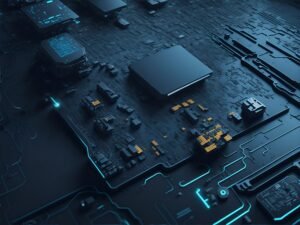In the ever-evolving landscape of mobile technology, smartphones have become an integral part of our daily lives, offering a myriad of functionalities beyond mere communication. One of the key components driving the performance of modern smartphones is the Graphics Processing Unit (GPU). This article delves into the intricacies of GPU utilization in smartphones, exploring their evolution, significance, and the impact on user experiences.
-
Evolution of GPUs in Smartphones:
The journey of GPUs in smartphones traces back to the early 2000s when mobile devices primarily focused on basic tasks. As consumer demands increased, so did the need for enhanced graphics capabilities. The first notable shift occurred with the introduction of 3D gaming on mobile platforms, prompting manufacturers to integrate dedicated GPUs to handle the increasing graphical complexities.
Initially, GPUs were integrated into the system-on-chip (SoC), sharing resources with the central processing unit (CPU). Over time, advancements in semiconductor technology allowed for more powerful GPUs to be integrated, leading to the emergence of dedicated mobile GPUs from companies like Qualcomm’s Adreno, ARM’s Mali, and Apple’s custom-designed GPUs.
-
Significance of GPUs in Smartphones:
a. Graphic Intensive Applications:
Modern smartphones are not merely communication devices; they serve as portable multimedia hubs, capable of handling graphic-intensive applications such as gaming, augmented reality (AR), and virtual reality (VR). GPUs play a pivotal role in rendering high-quality graphics and ensuring smooth gameplay, providing users with immersive experiences.
b. Display Resolutions and Refresh Rates:
The constant push for higher display resolutions and refresh rates places a substantial burden on the GPU. Whether it’s streaming high-definition videos or navigating through a responsive user interface, the GPU ensures that visual elements are displayed with precision and fluidity.
c. Machine Learning and AI:
Smartphones have embraced machine learning and artificial intelligence (AI) for various applications, including image recognition, language processing, and predictive user experiences. Modern GPUs are equipped with AI-specific cores, accelerating these tasks and contributing to the efficiency of AI-powered features on smartphones.
-
GPU Architecture and Configurations:
a. Unified Shading Architecture:
GPU architectures in smartphones have evolved to incorporate unified shading architectures, where a single set of shader cores handles both vertex and pixel processing tasks. This design enhances flexibility and efficiency, allowing GPUs to adapt to diverse workloads.
b. Multi-Core Configurations:
Manufacturers often opt for multi-core GPU configurations to distribute the processing load effectively. Dual-core, quad-core, and even octa-core GPU setups are common in high-end smartphones, ensuring optimal performance for various applications and workloads.
c. Thermal Considerations:
Efficient thermal management is crucial for smartphones, given their compact form factor. GPU designs in smartphones prioritize power efficiency and thermal performance to prevent overheating and maintain sustained performance during prolonged usageIn GPU Evolution in Smartphones .
-
GPU and Gaming Experience:
a. Mobile Gaming Revolution:
The gaming landscape on smartphones has undergone a paradigm shift, evolving from simple 2D games to graphically intensive 3D titles. GPUs play a pivotal role in delivering console-quality gaming experiences on handheld devices, with support for advanced features like real-time ray tracing and high frame rates.
b. Game Optimization:
Smartphone manufacturers collaborate with game developers to optimize titles for specific GPUs, ensuring a seamless gaming experience. Technologies like variable refresh rates, HDR support, and anti-aliasing contribute to visually stunning and responsive gameplay.
c. Cloud Gaming and Remote Rendering:
The rise of cloud gaming services relies heavily on the GPU’s ability to stream and render high-quality game content remotely. Smartphones equipped with robust GPUs can tap into these services, allowing users to enjoy high-end gaming experiences without the need for powerful local hardware.
-
Future Trends and Challenges :
a. Ray Tracing on Smartphones:
Ray tracing, a rendering technique that simulates the way light interacts with virtual environments, has been a hallmark feature in high-end gaming PCs and consoles. The integration of ray tracing capabilities in smartphones is on the horizon, promising enhanced realism and visual fidelity in mobile gaming and applications.
b. 5G and Edge Computing:
The advent of 5G connectivity and edge computing introduces new possibilities for offloading complex tasks to remote servers. GPUs in smartphones can collaborate with cloud-based resources to deliver augmented reality experiences, real-time rendering, and other demanding applications with reduced latency.
c. Sustainability Challenges:
As GPUs become more powerful, energy consumption and sustainability concerns come to the forefront. Smartphone manufacturers are under pressure to balance performance with energy efficiency, exploring innovative solutions such as AI-driven power management and more energy-efficient GPU architectures.
Conclusion Of GPU Evolution in Smartphones:
The GPU Evolution in Smartphones has been instrumental in transforming these devices into powerful multimedia and gaming platforms. From humble beginnings as basic graphics accelerators, modern mobile GPUs now rival the capabilities of dedicated gaming consoles. As we look to the future, the integration of advanced technologies like ray tracing and the collaboration between GPUs and emerging connectivity standards are set to redefine the possibilities of mobile computing. Smartphones, equipped with increasingly sophisticated GPUs, continue to push the boundaries of what was once thought possible, offering users an ever-expanding realm of immersive and engaging experiences.
People also Ask :







Pingback: Mastering Device Performance: A Deep Dive into Internal Storage and RAM Types for Optimal Speed and Multitasking - hiphonest.com
Несомненно трендовые новости модного мира.
Все эвенты самых влиятельных подуимов.
Модные дома, торговые марки, высокая мода.
Лучшее место для модных хайпбистов.
https://fashionvipclub.ru/
Полностью свежие события модного мира.
Исчерпывающие новости самых влиятельных подуимов.
Модные дома, торговые марки, haute couture.
Самое лучшее место для стильныех людей.
https://sneakero.ru/
Самые трендовые новинки мира fashion.
Абсолютно все события лучших подуимов.
Модные дома, торговые марки, высокая мода.
Интересное место для трендовых людей.
https://sneakerside.ru/
Наиболее свежие новинки моды.
Абсолютно все эвенты самых влиятельных подуимов.
Модные дома, бренды, haute couture.
Самое лучшее место для модных хайпбистов.
https://sneakersgo.ru/
All wristwatch news and events. Fresh collections, models. All information about legendary watch companies.
https://chrono.luxepodium.com/
Очень важные события мировых подиумов.
Исчерпывающие события всемирных подуимов.
Модные дома, лейблы, гедонизм.
Интересное место для стильныех хайпбистов.
https://ulmoda.ru/
Полностью важные события мировых подиумов.
Абсолютно все новости мировых подуимов.
Модные дома, торговые марки, haute couture.
Лучшее место для стильныех хайпбистов.
https://paris.luxepodium.com/
Fashion, luxury, travel
Perfect fashion startpage for hypebeasts and stylish people.
Podium news, events. New collections, collaborations, limited editions.
https://watch.lepodium.net/
Полностью стильные новинки моды.
Все мероприятия всемирных подуимов.
Модные дома, торговые марки, haute couture.
Интересное место для модных хайпбистов.
https://richlifestyle.ru/
Полностью свежие новости мировых подиумов.
Актуальные эвенты известнейших подуимов.
Модные дома, лейблы, высокая мода.
Самое лучшее место для модных людей.
https://furluxury.ru/
Несомненно актуальные новинки модного мира.
Актуальные события известнейших подуимов.
Модные дома, бренды, haute couture.
Лучшее место для модных людей.
https://balenciager.ru/
Полностью актуальные новости мировых подиумов.
Актуальные новости известнейших подуимов.
Модные дома, лейблы, высокая мода.
Самое приятное место для модных хайпбистов.
https://outstreet.ru/
LeCoupon: трендовые события для любителей fashion шоппинга
Новости, события, модные образы, мероприятия, коллекции, подиум.
https://qrmoda.ru/
LeCoupon: свежие новинки для любителей вещевого шоппинга
Новости, события, актуальные образы, мероприятия, коллекции, показы.
https://qrmoda.ru/
Полностью важные события мира fashion.
Важные мероприятия всемирных подуимов.
Модные дома, лейблы, haute couture.
Приятное место для стильныех людей.
https://egomoda.ru/
Очень стильные события моды.
Важные эвенты мировых подуимов.
Модные дома, лейблы, высокая мода.
Приятное место для трендовых хайпбистов.
https://whitesneaker.ru/
Несомненно важные события моды.
Исчерпывающие новости известнейших подуимов.
Модные дома, бренды, haute couture.
Лучшее место для модных хайпбистов.
https://urban-moda.ru/
Очень стильные события модного мира.
Актуальные новости самых влиятельных подуимов.
Модные дома, лейблы, haute couture.
Свежее место для трендовых хайпбистов.
https://worldsfashion.ru/
Стильные советы по подбору крутых образов на любой день.
Мнения профессионалов, события, все коллекции и мероприятия.
https://omskdaily.ru/news/2024-09-15-kak-otlichit-originalnuyu-veshch-balmain-ot-poddelki-klyuchevye-priznaki-i-sovety/